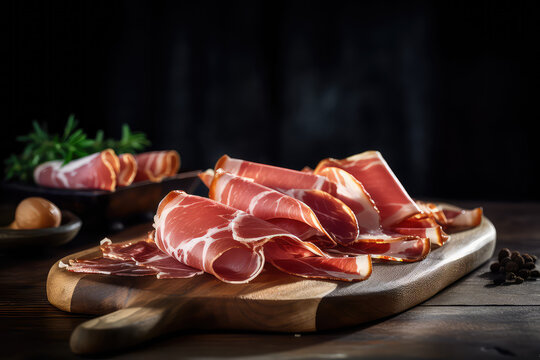The Ultimate Guide to Cappacuolo Meat: A Gourmet Delight for Food Enthusiasts

Cappacuolo meat, also known as capicola or coppa, is a cured Italian delicacy celebrated for its rich flavor and velvety texture. Whether you’re a foodie exploring gourmet meats or someone interested in enhancing your charcuterie board, cappacuolo meat offers a unique culinary experience. In this comprehensive guide, we’ll dive deep into its origins, production process, uses, and why it’s becoming a favorite among meat lovers.
What is Cappacuolo Meat?
Cappacuolo meat is a type of dry-cured pork derived from the shoulder or neck of the pig. Renowned for its balance of lean meat and marbled fat, this delicacy is seasoned with a variety of spices before being cured for weeks or even months. Its flavor profile is a blend of savory, spicy, and slightly sweet notes, making it a versatile addition to many dishes.
The Origins of Cappacuolo Meat
Cappacuolo meat has its roots in Italy, specifically in the southern regions like Calabria and Campania. Its name comes from a combination of “capo,” meaning head, and “collo,” meaning neck, referencing the cut of meat used in its preparation. Traditionally, it was a staple in Italian households, made during the colder months when curing meats was ideal for preservation.
How is Cappacuolo Meat Made?
The production of cappacuolo meat involves several meticulous steps that contribute to its distinctive taste and texture:
- Selection of Meat: Only high-quality pork is chosen, typically from the neck or shoulder.
- Trimming and Seasoning: The meat is trimmed of excess fat and seasoned with a blend of spices, which may include black pepper, garlic, paprika, and fennel seeds.
- Curing Process: After seasoning, the meat is wrapped in a natural casing and tied tightly to maintain its shape.
- Aging: The cappacuolo is hung in a controlled environment to dry and cure, allowing the flavors to develop. This process can last anywhere from three weeks to six months.
Cappacuolo Meat vs. Other Cured Meats
While cappacuolo meat shares similarities with prosciutto and salami, it stands out due to its unique cut and seasoning. Unlike prosciutto, which is made from the hind leg, cappacuolo comes from the neck, giving it a distinct marbling. Its spice blend also sets it apart from other cured meats, often offering a spicier kick.
Nutritional Profile of Cappacuolo Meat
Cappacuolo meat is not only delicious but also offers some nutritional benefits when consumed in moderation:
- Protein: Rich in high-quality protein, essential for muscle repair and growth.
- Low Carb: Ideal for low-carb or keto diets.
- Micronutrients: Provides essential vitamins and minerals, such as iron and zinc.
Culinary Uses of Cappacuolo Meat
One of the reasons cappacuolo meat is so beloved is its versatility in the kitchen.
1. Charcuterie Boards
Cappacuolo meat is a star ingredient on charcuterie boards, paired with cheeses, olives, and crackers. Its robust flavor complements mild cheeses like brie or sharp ones like aged cheddar.
2. Sandwiches and Paninis
Layer cappacuolo meat in sandwiches with fresh mozzarella, basil, and sun-dried tomatoes for an Italian-inspired lunch. Its spicy undertones elevate any sandwich recipe.
3. Pizza Topping
Thinly sliced cappacuolo meat makes an excellent pizza topping, adding a burst of flavor to Margherita or white pizzas.
4. Pasta Dishes
Chop and sauté cappacuolo meat as a base for pasta sauces, combining it with garlic, tomatoes, and olive oil for a rich, savory dish.
5. Salads
Add sliced cappacuolo to salads for a protein boost. Its bold taste pairs well with arugula, parmesan, and balsamic dressing.
Tips for Buying and Storing Cappacuolo Meat
- Buying: Look for cappacuolo meat at Italian delis, gourmet markets, or online specialty stores. Ensure it has a rich marbled texture and fresh aroma.
- Storing: Wrap it in parchment paper and store it in the refrigerator. For longer storage, vacuum-seal and freeze it, ensuring its flavors remain intact.
The Growing Popularity of Cappacuolo Meat
As consumers become more adventurous with their food choices, cappacuolo meat has seen a surge in popularity. Its inclusion in charcuterie boards and gourmet dishes has made it a favorite at restaurants and home kitchens alike. Food enthusiasts appreciate its artisanal nature and the care that goes into its preparation.
How to Make Cappacuolo Meat at Home
For those interested in DIY culinary projects, making cappacuolo meat at home can be a rewarding experience. Here’s a simplified process:
- Ingredients:
- Pork shoulder or neck
- Salt
- Spices (black pepper, paprika, fennel, garlic)
- Natural casing
- Preparation:
- Trim the pork, season it thoroughly, and let it sit overnight.
- Wrap it in the casing and tie it securely.
- Curing:
- Hang it in a cool, humid environment for 4-6 weeks.
- Check periodically to ensure proper drying.
While the process requires patience, the result is a homemade delicacy tailored to your taste preferences.
Frequently Asked Questions About Cappacuolo Meat
1. Is cappacuolo meat spicy?
It can be mildly spicy, depending on the seasoning used. Spicier versions often include red chili flakes.
2. Can cappacuolo meat be cooked?
While traditionally served raw in thin slices, it can be cooked for specific recipes, like pasta or pizza.
3. Is cappacuolo meat gluten-free?
Yes, most authentic cappacuolo meat is naturally gluten-free. However, check labels for additives if purchasing pre-packaged varieties.
Conclusion
Cappacuolo Meat is a culinary gem that deserves a spot in every food lover’s repertoire. From its rich history and meticulous preparation process to its versatile uses, this Italian cured meat has something to offer everyone. Whether you’re crafting a charcuterie board, enhancing a dish, or savoring it on its own, cappacuolo meat brings a taste of Italy to your table.
Start exploring the world of Cappacuolo Meat today and elevate your dining experience!

